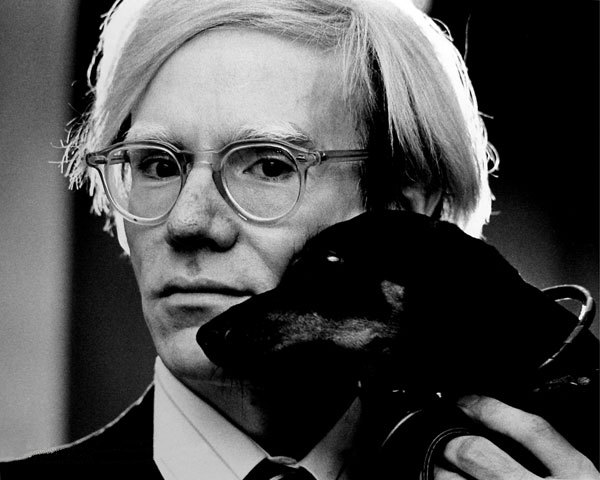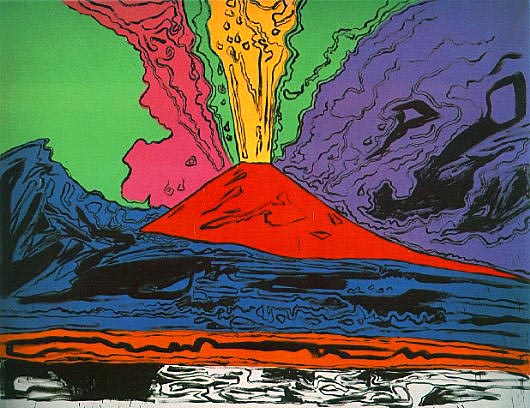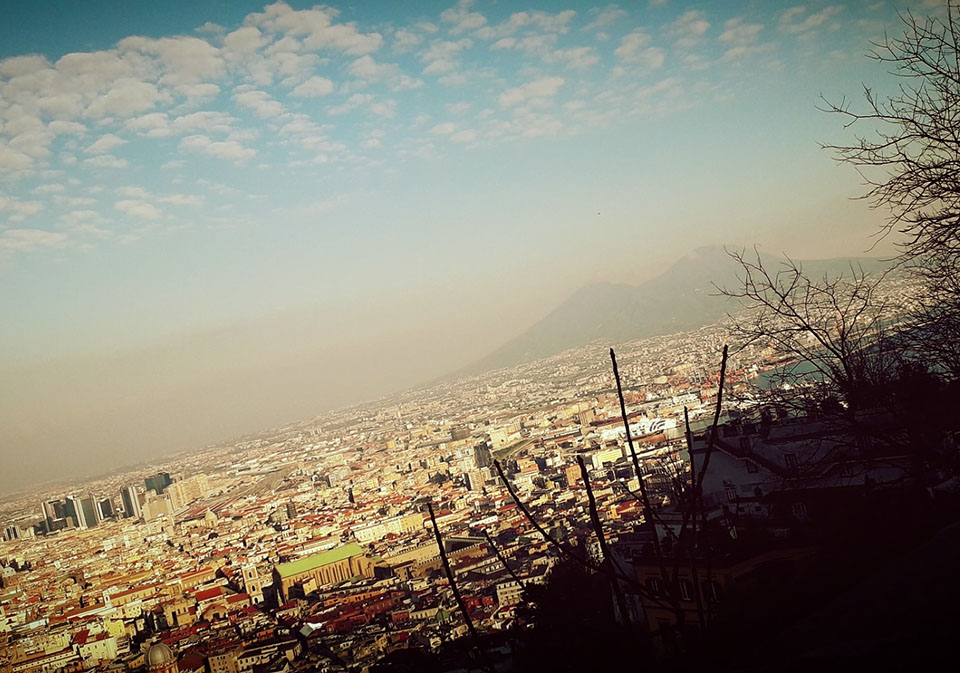Andy Warhol, Vesuvius
(Italian Version below*)
For me, the eruption is a shocking image, an extraordinary event and also a large piece of sculpture […] Vesuvius for me is much bigger than a myth: it is a terribly real thing.
Living in Naples in the 80s has always been my hidden desire. My mind has always been fascinated by this international environment, recreated thanks to the experimentation of the gallery owner Lucio Amelio.
Lucio Amelio had inaugurated the city Modern Art Agency in 1965. Here in a short time, for a succession of exhibitions, the major artists of the time came together. From Cy Towbly to Robert Rauschenberg, passing through Mimmo Paladino, Keith Haring and Kunellis, and others.
The “gallery” is a meeting place from which collaborations and masterpieces will be born. Andy Warhol and Joseph Beuys also came to town in those years.
They are joined by another pivotal figure who follows them with a click in their activities: the photographer Mimmo Jodice.
In this volcanic environment in 1985 the Capodimonte Museum houses the “personal” exhibition of Andy Warhol. This is the occasion in which he realizes the famous series “Vesuvius”, what Neapolitans often call “A muntagn” (the mountain) is revised in a pop key in its maximum eruption.
A canvas of this series is still on display and visible in the contemporary section of the Capodimonte Museum.
Andy reproduces, thanks to the screen printing technique, the symbol of the city of Naples and consecrates it even more to immortality with its unique style. Screen printing is a technique born in the East (Orient) that spread in the early twentieth century in the United States; among its advantages, there is precisely the possibility of repeating the same image with infinite color variations.
Warhol chooses it to express pop-art. He used to say that life is nothing more than a series of images that change only in the way they repeat themselves.
We are ready after this brief introduction to fly magically, thanks to the power of technology, first of all in the exhibition venue of this work. With google maps, we will be projected into the fantastic green lung of the Real Bosco di Capodimonte and from here we will enter the Museum, in the contemporary section. Another very useful tool for a better definition of the image is the catalog offered by Google Art & Culture.
By clicking in Google, with the mouse cursor we can enlarge our work to look at the details which in this case are the color variations based on a fluorescent mood and share it. It is also interesting to research other images from the same series to see how the artist decides to reproduce the same image.
If you are curious about the theme of PopArt, you can click here and if you are interested in a nice documentary, this BBC product is the one for you, A day in the life of Andy Warhol.
—————————————————————————————————————–
Per me l’eruzione è un’immagine sconvolgente, un avvenimento straordinario ed anche un grande pezzo di scultura […] Il Vesuvio per me è molto più grande di un mito: è una cosa terribilmente reale.
Vivere a Napoli negli anni ‘80 è sempre stato un mio recondito desiderio. La mia mente è sempre stata affascinata da questo ambiente internazionale, ricreato grazie alla sperimentazione del gallerista Lucio Amelio.
Lucio Amelio aveva inaugurato in città la Modern Art Agency nel 1965. Qui in breve tempo, per un susseguirsi di mostre, confluirono i maggiori artisti dell’epoca. Da Cy Towbly a Robert Rauschenberg, passando per Mimmo Paladino, Keith Haring e Kunellis, e altri.
La “galleria” è un luogo di incontri da cui nasceranno collaborazioni e capolavori. Arrivarono in città in quegli anni anche Andy Warhol e Joseph Beuys.

A loro si affianca un’altra figura cardine che li segue con un click nelle loro attività: il fotografo Mimmo Jodice.
In questo ambiente vulcanico nel 1985 il Museo di Capodimonte ospita la “personale” di Andy Warhol. E’ questa l’occasione in cui realizza la celebre serie “Vesuvius”, quella che i napoletani spesso chiamano “A muntagn” è rivista in chiave pop nella sua massima eruzione.
Una tela di questa serie è tutt’ora esposta e visibile nella sezione contemporanea del Museo di Capodimonte.

Andy riproduce, grazie alla tecnica serigrafica, il simbolo della città di Napoli e lo consacra ancora di più all’immortalità con il suo stile unico. La serigrafia è una tecnica nata in Oriente che si diffonde agli inizi del XX secolo negli Stati Uniti; tra i suoi vantaggi c’è appunto la possibilità di ripetere con infinite varizioni coloristiche la medesima immagine.
Warhol la sceglie per esprimere la popart. Era solito affermare che la vita non è altro che una serie di immagini che cambiano solo nel modo di ripetersi.
Siamo pronti dopo questa breve introduzione a volare magicamente, grazie al potere della tecnologia, innanzitutto nella sede espositiva di quest’opera. Con google maps saremo proiettati nel fantastico polmone verde del Real Bosco di Capodimonte e da qui entreremo al Museo, nella sezione contemporanea. Altro strumento utilissimo per una maggiore definizione dell’immagine è il catalogo offerto da Google Art & Culture.
Cliccando in Google, con il cursore del mouse possiamo ingrandire la nostra opera per guardare i dettagli che in questo caso sono le variazioni di colore basate su un mood fluo e condividerla. E’ interessante anche ricercare altre immagini della medesima serie per vedere come l’artista decide di riproporre la medesima immagine.
Se volete approfondire il tema della PopArt, potete cliccare qui e se siete interessati ad un bel documentario, questo prodotto dal BBC è quello che fa per voi, A day in the life of Andy Warhol.
Sostieni la #culturachevince, aiuta la condivisione.

Tutti i diritti sono riservati. E’ vietata qualsiasi utilizzazione, totale o parziale, dei contenuti inseriti nel presente portale, ivi inclusa la memorizzazione, riproduzione, rielaborazione, diffusione o distribuzione dei contenuti stessi mediante qualunque piattaforma tecnologica, supporto o rete telematica, senza previa autorizzazione scritta di Selenia Morgillo.
One Reply to “Andy Warhol, Vesuvius”
Grazie per quest’apertura alla PopArt! Molto interessante